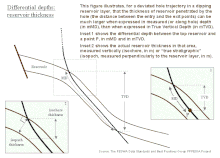Depth in a well: Difference between revisions
Sfan00 IMG (talk | contribs) 2 images removed - deleted |
Undid revision 365324436 by Sfan00 IMG (talk) |
||
| Line 10: | Line 10: | ||
* Well depth values from the [[Wireline logging|wireline loggers]] operation are referred to as "loggers depth". The loggers depth are typically considered more reliable than the drillers depth. |
* Well depth values from the [[Wireline logging|wireline loggers]] operation are referred to as "loggers depth". The loggers depth are typically considered more reliable than the drillers depth. |
||
* The difference between loggers and drillers depth are due to different stretch in the drilling string when drilling, and the wire line entered into the bore hole during wireline logging operations. This difference is estimated and referred to as "core shift". A core from a certain drillers depth is lined up with a wireline log (loggers depth) and structures in the core are compared with the log and matched. |
* The difference between loggers and drillers depth are due to different stretch in the drilling string when drilling, and the wire line entered into the bore hole during wireline logging operations. This difference is estimated and referred to as "core shift". A core from a certain drillers depth is lined up with a wireline log (loggers depth) and structures in the core are compared with the log and matched. |
||
==Figures== |
|||
[[Image:SpecDepth1.gif|thumb|left|Fig. 1: The specification of depths {{deletable image-caption|Sunday, 9 May 2010}}]][[Image:SpecDepth2.gif|thumb|right|Fig. 2: Differential depths: reservoir thickness, isochor, isopach {{deletable image-caption|Sunday, 9 May 2010}}]] |
|||
==External references== |
==External references== |
||
Revision as of 15:04, 9 September 2010
In the oil and gas industry, depth in a well is the measurement, for any point in that well, of the distance between a reference point or elevation, and that point. It is the most common method of reference for locations in the well, and therefore, in oil industry speech, "depth" also refers to the location itself.
By extension, depth can refer to locations below, or distances from, a reference point or elevation, even when there is no well. In that sense, depth is a concept related to elevation, albeit in the opposite direction. Depth in a well is not necessarily measured vertically or along a straight line.
Because wells are not always drilled vertically, there may be two "depths" for every given point in a wellbore: the measured depth (MD) measured along the path of the borehole, and the true vertical depth (TVD), the absolute vertical distance between the datum and the point in the wellbore. In perfectly vertical wells, the TVD equals the MD; otherwise, the TVD is less than the MD measured from the same datum. Common datums used are ground level (GL), drilling rig floor (DF), rig table (RT), and kelly bushing (KB).
Depth in a well as used in the oil and gas industry
- Well depth values taken during the drilling operation are referred to as "drillers depth". The "total depth" for the well, core depths and all analysis of core / mud and other materials from the drilling hole are measured in "drillers depth".
- Well depth values from the wireline loggers operation are referred to as "loggers depth". The loggers depth are typically considered more reliable than the drillers depth.
- The difference between loggers and drillers depth are due to different stretch in the drilling string when drilling, and the wire line entered into the bore hole during wireline logging operations. This difference is estimated and referred to as "core shift". A core from a certain drillers depth is lined up with a wireline log (loggers depth) and structures in the core are compared with the log and matched.
Figures

This file may be deleted after Sunday, 9 May 2010.

This file may be deleted after Sunday, 9 May 2010.
External references
- Lowest Astronomical Tide (LAT)
- Seas and Submerged Lands Act 1973 (Australia)
- Log Data Acquisition and Quality Control, Ph. Theys, 1991, Editions Technip
